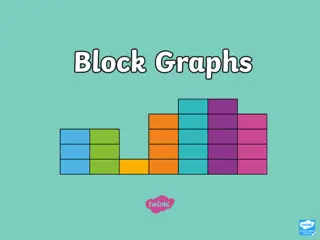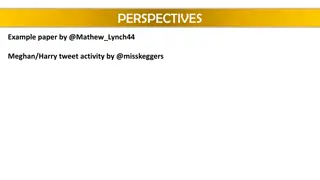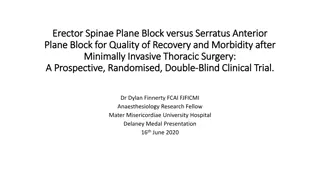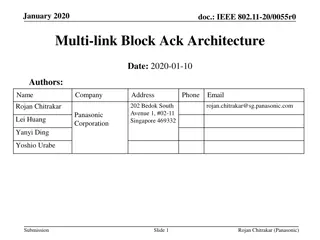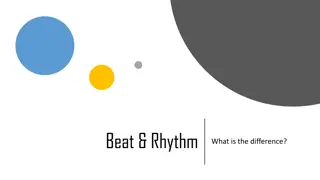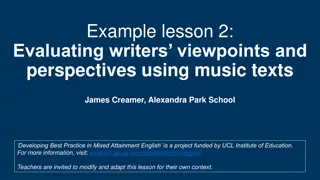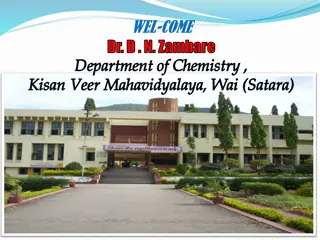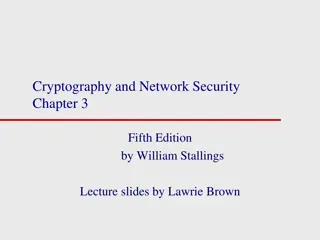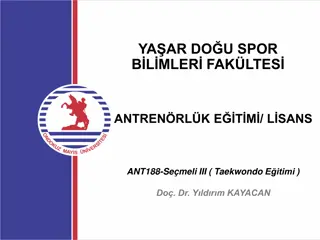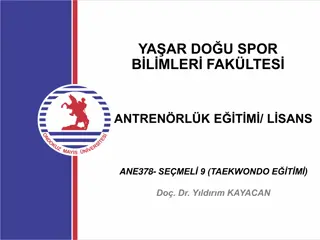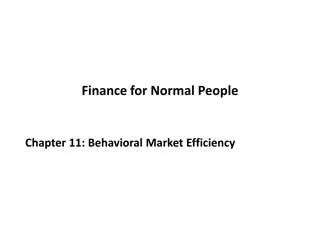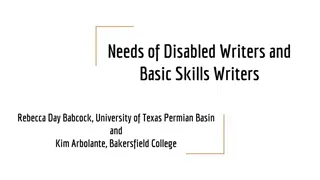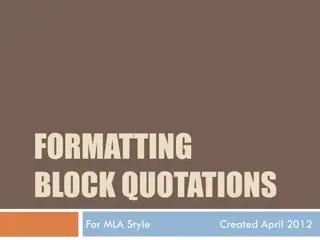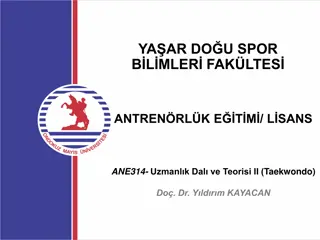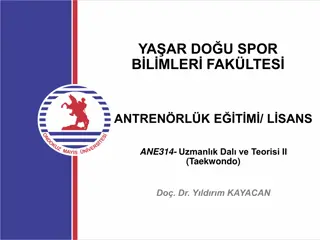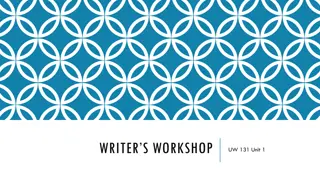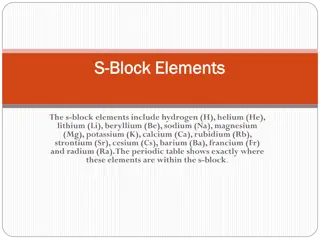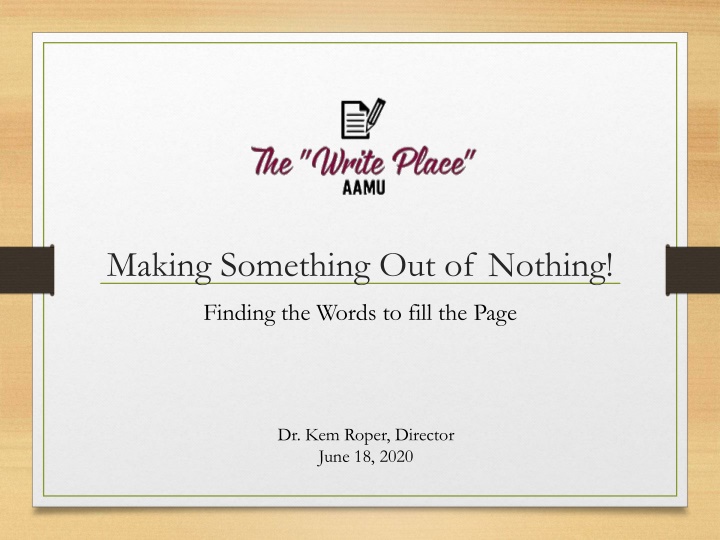
Creative Writing Process Tips and Strategies
Discover valuable insights on the creative writing process, including overcoming writer's block, time management strategies, and steps to enhance your writing. Learn how to begin your writing journey, allocate time effectively, and optimize your creative output.
Download Presentation

Please find below an Image/Link to download the presentation.
The content on the website is provided AS IS for your information and personal use only. It may not be sold, licensed, or shared on other websites without obtaining consent from the author. If you encounter any issues during the download, it is possible that the publisher has removed the file from their server.
You are allowed to download the files provided on this website for personal or commercial use, subject to the condition that they are used lawfully. All files are the property of their respective owners.
The content on the website is provided AS IS for your information and personal use only. It may not be sold, licensed, or shared on other websites without obtaining consent from the author.
E N D
Presentation Transcript
Making Something Out of Nothing! Finding the Words to fill the Page Dr. Kem Roper, Director June 18, 2020
What do we mean by Process? WHAT IT S NOT WHAT IT IS Linear Recursive intro, body, conclusion questioning, thinking, drafting
Fact: Real writers suffer from writers block Forgive: Release yourself from the need to be perfect Give yourself time to write badly Forget: Put the critic in the closet Fun: Explore! Exercise Set yourself up for success Focus: Tie yourself to the chair
What do we mean by Process? The process requires: Time Thinking Spacing
So, how do I begin? Give yourself AT LEAST 3 days before the due date to write Give yourself a different task for each day Save editing for the last day
If you only have 3 days Day 1: think & free write Day 2: read, think, write & re-write Day 3: read, think, revise, edit (print & rejoice!)
If you have more than 3 days Day 1-3: think and free write Day 3-5: read, think, write & re-write Day 5-7: read, think & revise Day 8: read, think, edit, print & rejoice!
LET US HELP! The best time to come to the writing center is early in your process. (DAY 1 OR 2) We do our best work at the beginning!
Day 1: think and free write What is my topic? What are the specific issues related to this topic? What are the specific issues that I want to focus on? What do I already know about this? What opinions do I have about this? Where do my thoughts and opinions come from? Experiences, observations, personality, family/upbringing
Day 1: think and free write What does the assignment require? What questions must be answered or what information included? Gather what you need If you re doing research, look for sources that will help to answer these questions BUT YOU ANSWER THE QUESTIONS FIRST!
if youre doing research You re question to yourself should be: how does this information compare to what I already know? Does it confirm, refute or enrich my understanding of this topic? Write down your answers to these questions!
Day 1: techniques Free-writing Listing (or clustering) Speaking into recorder Conversing Generate Ideas: 5Ws (journalist questions) 5 Senses (Look, Touch, Taste, Feel, Smell)
PRACTICE! I ll set the timer and for the next 5 minutes practice one of the Day 1 writing techniques Free-writing Listing (or clustering) 5Ws (journalist questions) 5 Senses (Look, Touch, Taste, Feel, Smell)
Day 2: read, think, write & re-write Read what you wrote on Day 1 Think about it. What can you add? What should you change? Do your responses answer the important questions? What is missing? Which questions can you not answer?
Day 2: read, think, write & re-write If you re writing a research paper, the questions that you can t answer should point you to the resources you need to look for Spend some time reading & taking notes on the reading (Go to the Write Place website Tutorials ) If you have a long research paper to write, your day 2 may need to stretch out to day, 3, 4 and 5!
Day 2: read, think, write & re-write If you re not doing research or once you ve read and taken notes on your reading 1. Think about what you have written and how it can be structured 2. If there are questions you can t answer, include the limitations in your writing or shift your focus to what you do know 3. To determine what to keep and what to toss, consider your purpose and audience
Day 2: read, think, write & re-write This might be where some of you get stuck! You ve explored the topic, written what was on your mind and you still only have 2-3 pages of what should be a longer essay NOW WHAT?
How do I Say More? If you re writing a research paper, saying more is fairly easy because you must balance what you say with what they which often provides many opportunities to elaborate. For more on responding to sources, attend our upcoming workshop on Writing the Lit. Review
How do I Say More? Whether your writing a research paper or not, try this! Think about the main point that you want to make Can you find a working thesis in your draft so far? Take one statement that asserts a point/perspective and follow the S.E.E.I formula to develop
Technique for How to Say More S.E.E.I State write the statement Elaborate follow with an elaboration on that statement ( in other words ) Exemplify give an example that shows an actual instance of that thing Illustrate give an illustration that compares that thing to something that it s like
SEEI Example State Writing can be hard. Elaborate Thoughts come to us randomly, sporadically and at different times, so we have to take the time to think things through. Exemplify When I have a paper to write, I spend a lot of time figuring out what I want to say. My ideas are usually all over the place at first, so I have to make lists or free write for a while before I actually start. Illustrate Writing is like organizing your sock drawer. You have to dump out all the ideas first, then put them together one by one until all of the like things are together!
Day 2: read, think, write, re-write 1. Continue using SEEI for every point that you make. This method should help you to effectively elaborate on each point 2. Do this exercise over a couple of days, not all in one sitting 3. Allow yourself time to read and re-read what you ve written
Day 3: read, think, revise Organize! 1. Once you have some stuff to work with you can begin organizing what you ve written 2. Now is the time to think about the structure of your essay 3. Who is your audience? 4. What does the professor require?
Day 3: read, think, revise Outline Introduction (how can I set up this discussion?) Thesis (what is my main point?) Background Information (what information would my reader need in order to know what I know?) Supporting Information (what will I use to support my main point?) details, examples, research
Day 3: read, think, revise PARAGRAPHING Read over what you ve written and create paragraphs Each paragraph should focus on ONE POINT EACH POINT should connect to the point that follows in the next paragraph
Day 3: read, write, revise TWO IMPORTANT POINTS TO CONSIDER Revision is not the same as editing Drafting is not writing an entire essay from start to finish
Draft What is a draft? Everything you write down relating to this topic What constitutes a first draft? Any ideas you put on paper regardless of form Drafts? Each time you add or delete what you ve written you re creating a new draft What constitutes a final draft? When you ve moved from revision to editing
What is a revision? Changing the content Overall idea what am I saying? Organization what is the best way to say this? Paragraphs what am I saying in each? Add to it Delete from it The purpose is to clarify your main point
Day 3 (or 8): read, think, revise edit last! Preferably, do your editing only when you are finished with the paper perhaps on a separate day Many writers revise and edit simultaneously, but it s important to distinguish between the two they are not the same work
Proofreading/Editing When your focus is not on content, but on structure Example: Sentence structure: fragments, run-ons Grammar: subject/verb agreement, verb tense, syntactical errors (comma splices, periods, question marks, exclamation points, semi-colons, commas, colons) Spelling, word choice, word usage
Day 3 (or 8): read, think, revise edit last! End where you began read what you wrote! Evaluate your paper before someone else does: PURPOSE (clear audience, subject, and genre) DIRECTION (proper structure, organization, logical order) IDEAS (connection to reader, specific details, variety) STYLE (expression, word choice, sentence variety, figurative language, etc...) PRESENTATION (spelling, punctuation, capitalization, paragraphing, neatness, pen or typed) Is this a good reflection of what you can do?
YOU KNOW WHERE TO FIND US! @writeplaceaamu @thewriteplaceaamu Carver Complex North, Hollins Wing, Rm 125 www.aamu.edu/writingcenter



